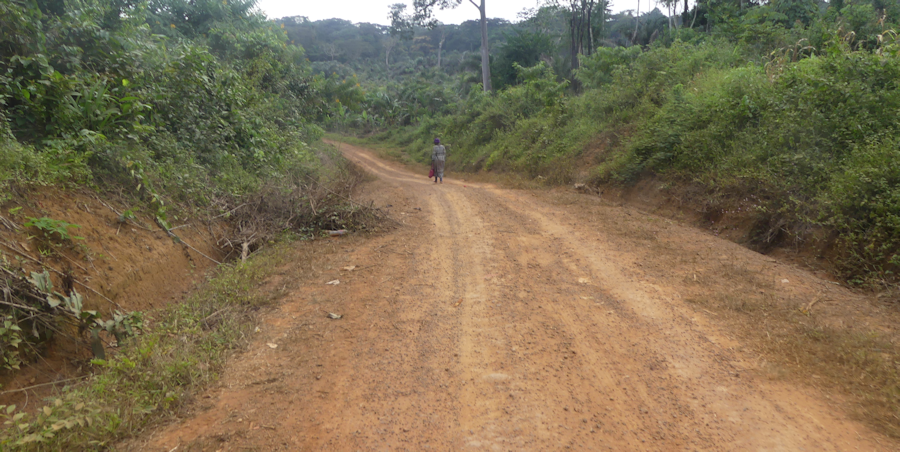Ñyé'án Ñkóbán Búlu - Añgan 18 - Biñgun Ê Bindòn
1. Bí á yé'è ñkóban Búlu.
B'á jô na jam é n'èndôndòn éyoñ jam éte d'á jêmbane èfó'o. Biñgun biziñ bí á beleban mfá'á yà jêt éndòn.
Èñgun éndòn é n'èñgun j'á líti èndôndòn ê mõt, èndôndòn ê tít, èndôndòn ônòn, èndôndòn ê jôm, ñgê k'èndôndòn ê jam.
_("We are learning to speak Bulu. Something (usually an event) is said to be uncertain if that thing (or event) lacks precision. Some pronouns are used to express uncertainty. A 'pronoun of uncertainty' is a pronoun that indicates uncertainty about a person, an animal, a bird, a thing, or an event."/"Nous apprenons à parler Boulou. On dit que quelque chose (peut-être un événement) est incertaine si cette chose manque de précision. Certains pronoms sont utilisés pour exprimer une incertitude. Un pronom d'incertitude est un pronom qui exprime une incertitude à propos d'un être humain, d'un animal, d'un oiseau, d'une chose, ou d'un événement.")_
Ñgê wo kób'ajô é tií aa mõte wuá, tít ê jiá, õnòne wúá, jôm ê jíá, ñgê ke jame dá, èñgun éndòn é ne:
èziñ
Õ ne belan èñgun éndòn áman ôseñge. Ású bive'án, tót ê mêjô maná:
M'a só ê vôm [ èziñ ].
Te wo vun èwól' [ èziñ ].
A a jô na á njí yi jôm [ èziñ ].
Õsé ô n'aka'á vió [ èziñ ].
Èmvañgên ê jam é njí ke wôé tít [ èziñ ].

Bisúá bí ñgá'an mvit. Ô njí ke sop ésúá [ èziñ ].
2. Ê mvú'áa èñgun éndòn "èziñ", õ ne kõ'õlan éfíá ñgê ke bifíá. Ású bive'án, tót ê mêjô maná:
_("After the pronoun of uncertainty, you can add add one or more words."/"Après le pronom d'incertitude, tu peux ajouter un ou plusieurs mots.")_

Me ñgá yên a tili'i jôm [ èziñ ] áfêp.
Ô njí lí'í jôm [ èziñ ] ê tawôlõ.

Èbutu a ndeme tôbane ndômán [ èziñ ] Étíson.
3. Õ ne belan èñgun éndòn ôseñg'été; èyoñ éte, wo yiane kõ'õlan ônyenyet éñgun ñgê k'èñgbwêñgbwên éñgun. Ású bive'án, tót ê mêjô maná:
_("You can use a pronoun of uncertainty inside a sentence. In that case, you must add a personal or a neutral pronoun."/"Tu peux utiliser un pronom d'incertitude à l'intérieur d'une phrase. Dans ce case, tu dois ajouter un pronom personnel ou un pronom neutre.")_

Kel'ê nyoñ ôtyeñ [ èziñ ô ] betê ê tawôlõ.
M'a nye'e mfóndé [ èziñ me ] wô'õ yên õ be'ê.
Éyoñ bí ñgá suan ábá, bí ñgá koene mõt [ èziñ a ] toó ê sí.
4. Õ símêsa'ane náa õ ne nyíñíli éfíá ñgê ke bifíá ê zàñ èñgun éndòn aa õnyenyet éñgun ñgê k'èñgbwêñgbwên éñgun. Ású bive'án, tót ê mêjô maná:
Món [ èzín a ] a kon.
Món [ èzín bí ñgá bíáé ê Tunízia a ] a kon ntúi.
Andó'o [ èziñ é ] mane ya ê wúm.
Andó' [ èziñ é nê ê Mekalat é ] mane ya ê wúm.

Me ñgá yên ê ndá [ èziñ è ] dí'ik.
Éyoñe bí ñgá lõt ê njóñ, me ñgá yên ê ndá [ èziñ ya Áfanéñgoñ è ] dí'ik.
5. Biyoñ biziñ, wo yiane kõ'õlan éjêt:
èziñ + j'a ...
èziñ + j'á ...
Ású bive'án, tót ê mêjô maná:

M'a wô' édùñ [ éziñ j'á ] só ôkàñ.
Ye wo yeme biañ [ èziñ j'a ] sáé mbõman?
Fiañg' [ éziñ j'á ] sóo mintáñêtê.
6. Ñg'ájô d'á fombõ abui ê bõt, abui bêtít, abui ánòn, abui ê bíôm, ñgê k'abui ê mam, ñg'ômíês w'á tótêban avál èziñ, èñgun éndòn é ne:
bèziñ
Õ ne belan èñgun éndòn "bèziñ" áman ôseñge. Ású bive'án, tót ê mêjô maná:
Me ndeme báñête bõt [ bèziñ ].
Ô njí bi ê bendaé [ bèziñ ].
A a só ê nseñ ébumá. Á a jô na á njí yên ê bóñgô [ bèziñ ].
7. Ê mvú'áa èñgun éndòn "bèziñ", õ ne kõ'õlan éfíá ñgê ke bifíá. Ású bive'án, tót ê mêjô maná:
Éyoñ a nê Áwóló, a wô'õ tôbane bõt [ bèziñ ].
A wô'õ tôbane bõt [ bèziñ ] Áwóló.
Éyoñ bí ñgá suan ábá, bí ñgá koene bõt [ bèziñ ].
Bí ñgá koene bõt [ bèziñ ] Ábá.
Bí á ke Ákônôliñga. Bí á ke jom ê betí'a [ bèziñ ].
Bí á ke jom ê betí'a [ bèziñ ] Ákônôliñga.
8. Õ ne belan èñgun éndòn "bèziñ" ôseñg'été; èyoñ éte, wo yiane kõ'õlan ônyenyet éñgun ñgê k'èñgbwêñgbwên éñgun:
bèziñ + bê ...
Ású bive'án, tót ê mêjô maná:
Me wô'õ yên ê bôñgô [ bèziñ bê ] léè èwos.
Ê Báñgánté, betí'a [ bèziñ bê ] ne mfúbán.
Éyoñ bí ñgá suan ábá, bí ñgá koene bõt [ bèziñ bê ] kóbõ'õ ajô.
9. Õ símêsa'ane náa õ ne nyíñíli éfíá ñgê ke bifíá ê zàñ èñgun éndòn aa õnyenyet éñgun. Ású bive'án, tót ê mêjô maná:
Bí ñgá koene bõt [ bèziñ bê ] toó ê sí.
Bí ñgá koene bõt [ bèziñ ê Yà Mvañgan bê ] toó ê sí.
Bón [ bèzín bê ] têle ê nseñ.
Bón [ bèzín Tatê Ñkômõ a ñgá bíáé bê ] têle ê nseñ.
10. Biyoñ biziñ, wo yiane kõ'õlan éjêt ê "b'á":
bèziñ + b'á ...
Ású bive'án, tót ê mêjô maná:
Bóñgô [ bèziñ b'á ] nye'e bê wóba'ane mveñ.
Vós ê ndá! Beyêñ [ bèziñ b'á ] ye só aakítí.
Ye mvènè? M'a wô'ô bemvú [ bèziñ b'á ] yôn.
11. Ñg'ájô d'á fombõ abui ê bõt, abui bêtít, abui ánòn, abui ê bíôm, ñgê k'abui ê mam, ñg'ômíês w'á tótêban avál èziñ, èñgun éndòn é ne:
biziñ
Õ ne belan èñgun éndòn "biziñ" áman ôseñge. Ású bive'án, tót ê mêjô maná:
Éyoñ me mbê Áñgõlá, me ñgá jome bitísone [ biziñ ].

Bisúá bí ñgá'an mvit. Ô njí ke sop ê bisúá [ biziñ ].
Kel'ê man ê ba'aé tíl. Te wo sá'ále bilé [ biziñ ].
12. Õ ne belan èñgun éndòn "biziñ" ôseñg'été; èyoñ éte, wo yiane kõ'õlan ônyenyet éñgun ñgê k'èñgbwêñgbwên éñgun:
biziñ + bí ...
Ású bive'án, tót ê mêjô maná:
Me bilí bimvõñgá [ biziñ bí ] á ñgemban.
A wô'õ wô'ô bidùñ ê [ biziñ bí ] só'o ôkàñ.
Biyalán [ biziñ bí ] á funan melúman.
13. Ñg'ájô d'á fombõ abui ê bõt, abui bêtít, abui ánòn, abui ê bíôm, ñgê k'abui ê mam, ñg'ômíês w'á tótêban avál èziñ, èñgun éndòn é ne:
mèziñ
Õ ne belan èñgun éndòn "mèziñ" áman ôseñge. Ású bive'án, tót ê mêjô maná:
Ê Báfúsam, me ñgá nyu meyo'o [ mèziñ ].
Êyoñ wo ê ku ñkaná, wo yê'êle mam [ mèziñ ].
A wô'õ lí ve mefálá'á [ mèziñ ].
14. Õ ne belan èñgun éndòn "mèziñ" ôseñg'été; èyoñ éte, wo yiane kõ'õlan ônyenyet éñgun ñgê k'èñgbwêñgbwên éñgun:
mèziñ + mê ...
Ású bive'án, tót ê mêjô maná:
Memvôé [ mèziñ mê ] ne mfí.
Mefan [ mèziñ mê ] bil'ábui bêtít.
Émvañgên ê jam, melám [ mèziñ mê ] wô'õ bíi étám.
Bí á ke sañ ê mendó'o [ mèziñ mê ] ñgá wúm.
Bí á ke sañ ê (bibumá yà) mendó'o [ mèziñ mê ] ñgá wúm (bibumá).
15. Biyoñ biziñ, wo yiane kõ'õlan éjêt ê "m'á":
mèziñ + m'á ...
Ású bive'án, tót ê mêjô maná:
Éyoñ mveñ j'a nóñ, mendá [ mèziñ m'á ] tóé.
Mejô [ mèziñ m'á ] funan metà.
Memvôé mèziñ mê ne mfí; ve memvôé [ mèziñ m'á ] kolè õbàk.
16. Õ símêsa'ane náa biyoñ biziñ, õ ne nyíñíli éfíá ñgê ke bifíá ê zàñ èñgun éndòn aa éñgun èvók. Ású bive'án, tót ê mêjô maná:
Mendá [ mèziñ m'á ] dík.
Mendá [ mèziñ ê yà Áfanéñgoñ m'á ] dík.
Mebiañ [ mèziñ m'á ] sáé mbõman.
Mebiañ [ mèziñ, an'ékuk, m'á ] sáé mbõman.
Menjáñ [ mèziñ m'á ] duñ anê mvêt.
Menjáñ [ mèziñ, á dañ ê dañ ê má mê n'évêle, m'á ] duñ anê mvêt.
17. Ñg'ájô d'á fombõ abui ê bõt, abui bêtít, abui ánòn, abui ê bíôm, ñgê k'abui ê mam, ñg'ômíês w'á tótêban avál èziñ, èñgun éndòn é ne:
miziñ
Õ ne belan èñgun éndòn "miziñ" áman ôseñge. Ású bive'án, tót ê mêjô maná:
M'a nye'e mimfóndé miõè [ miziñ ].
Bí á yiane ke éñgbwásá. Ye ô jep e ya ê mimfan [ miziñ ]?

Èvúlút é ñgá'án é têle ôkàñ. Á njí ke fol ê miñka [ miziñ ].
18. Õ ne belan èñgun éndòn "miziñ" ôseñg'été; èyoñ éte, wo yiane kõ'õlan éñgbwêñgbwên éñgun "mí":
miziñ + mí ...
Ású bive'án, tót ê mêjô maná:


Miñkõs [ miziñ mí ] á tili èvêle; ve miñkõs [ miziñ mí ] á tili èvíndi.
Miñkaná [ miziñ mí ] á lêp. Miñkaná [ miziñ mí ] á yê'êle mam.
Miñsòs ê [ miziñ mí ] n'abé; vedá, miñsòs ê [ miziñ mí ] ne mfí.
19. Õ símêsa'ane náa biyoñ biziñ, õ ne nyíñíli éfíá ñgê ke bifíá ê zàñ èñgun éndòn aa éñgun èvók. Ású bive'án, tót ê mêjô maná:
Minsílí [ miziñ mí ] á funane metà.
Minsílí [ miziñ bê ndeme síli mí ] á funane metà.
kulubá, bekulubá

Mimfóndé [ miziñ mí ] ne bekulubá.
Mimfóndé [ miziñ a wô'ô jáé mí ] á funane bekulubá.
Mimfèfè Bífíá
èndòn (abui: bindòn): uncertainty/incertitude
èndôndòn (abui: bindêndòn): uncertain/incertain
èñgun (abui: biñgun): pronoun/pronom
ntôõ (abui: mintôõ): next/suivant
ètõé-ètõé (abui: bitõé-bitõé): directly/directement
õmíês (abui: amíês): subject/sujet
ñkpwáa (abui: miñkpwáa): previous/précédent
õnyênyeñge èñgun (abui: anyênyeñge ê biñgun): distinctive pronoun/pronom distinctif
Mêñgan máná mê ne ású na bí yé'é anê b'á kóbô Búlu. Ñgê wo yêne jôm èziñ é n'ábé ñgê ke njuk, ñgê wo kômbô kómêkane, tili'i dê mfá'á ya bila'aé.
These lessons are meant to teach how to speak the Bulu language. If you have a comment, a suggestion, or a critique, please write it in the Comments section.
Ces leçons enseignent comment parler la langue Boulou. Si tu as des commentaires, des suggestions, ou des critiques, écris-les dans la section des commentaires. (n k o b o b u l u AT g m a i l dot c o m)
Nsámá'a-Ndetên: http://www.nkoboboulou.com